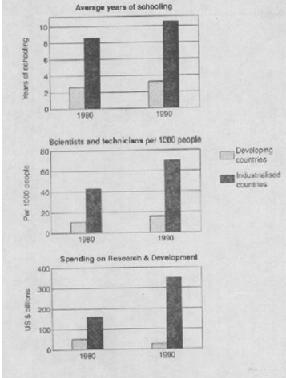(单词翻译:单击)
剑3 TEST3
The charts below show the levels of participation in education and science in developing and industrialized countries in 1980 and 1990.
Write a report for a university lecturer describing the information shown below.
范文:
The data shows the differences between developing and industrialized countries’ participation in education and science.
In terms of the number of years of schooling received, we see that the length of time people spend at school in industrialized countries was much greater at 8.5 years in 1980, compared to 2.5 years in developing countries. The gap was increased further in 1990 when the figures rose to 10.5 years and 3.5 years respectively.

We can see a similar pattern in the second graph, which shows that the number of people working as scientists and technicians in industrialized countries increased from 55 to 85 per 1,000 people between 1980 and 1990, while the number in developing countries went from 12 to 20.
Finally, the figures for spending on research and development show that industrialized countries more than doubled their spending, from $200bn to $420bn, whereas developing countries actually decreased theirs, from $750bn down to $25bn.
Overall we can see that not only are there very large differences between the two economies but that these gaps are widening.


